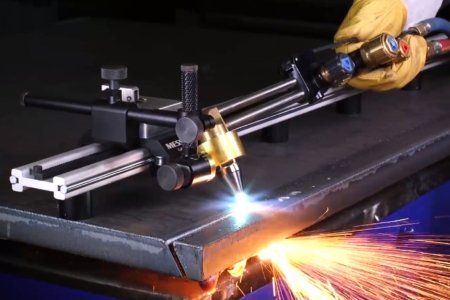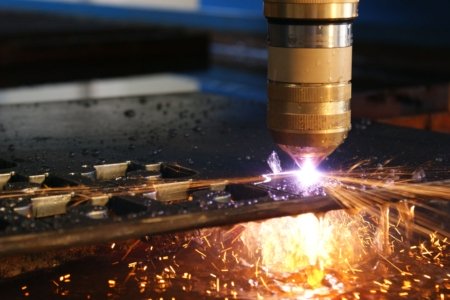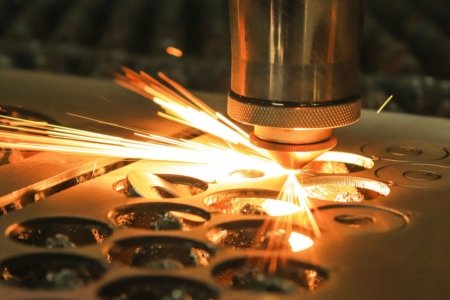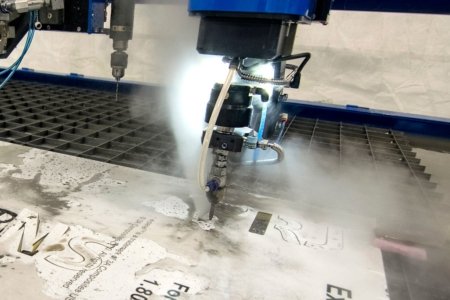Oxy-fuel Cutting (Flame Cutting)
What is Oxy-fuel Cutting?
Oxy-fuel cutting is the oldest and arguably the simplest method for cutting metal. This metal fabrication process uses a chemical reaction between oxygen and steel to form iron oxide. Using acetylene, propane, propylene and natural gases such as hydrogen; the temperature of the workpiece surface or edge is raised. Once hot enough (around 1000°C), a highly pressurised stream of oxygen is directed at the surface which then oxidises and becomes molten due to the exothermic reaction.

Things to Consider When Oxy-Fuel Cutting
The optimal thickness for oxy-fuel cutting is 300mm and thinner, however these machines are capable of cutting very thick material to depths of up to 1220mm. Because the workpiece needs to be pre-heated before cutting, this process can be slow. This technique will slightly round the edges on the surface of the workpiece, this can work to your advantage as the surface may not require further treatment.
Plasma Cutting
What is Plasma?
Simply put, plasma is one of the four fundamental states of matter – A highly electrically-conductive gas, formed of ions and free electrons. Plasma can be artificially created by heating a neutral gas (such as steam) to temperatures exceeding 20,000°C!
What is Plasma Cutting?
Plasma cutting is a process used in metal fabrication, for cutting through electrically conductive materials such as steel. The highly conductive gas (plasma) carries electricity from an electrode to the workpiece, which becomes molten and is then removed. The molten metal removed in the cutting process is known as dross.

Things to Consider When Plasma Cutting
The optimal thickness for plasma cutting mild steel plate is between 6mm and 38mm. Whilst this technique excels in speed, the edge quality starts to suffer when working with steel out of the optimal thickness range. However, compared to oxy-fuel cutting; plasma cutting is much quicker. This is because the workpiece does not need to be heated prior to cutting. Due to its efficiency; plasma cutting is a great method for large scale projects, although the running costs are more expensive. Consider productivity VS running costs.
Laser Cutting
What is Laser Cutting?
Laser cutting is a metal fabrication process used on sheet metal for cutting shapes. A Laser resonator emits a beam of high intensity light, of a single wavelength or colour. Mirrors inside the head of the laser cutter direct and focus the beam emitted from the resonator out of the nozzle and onto the workpiece. The laser beam melts the workpiece whilst laser gas (oxygen or nitrogen), also emitted from the nozzle, removes the molten metal.

Things to Consider When Laser Cutting
The optimal thickness for laser cutting mild steel plate is anywhere up to around 38mm. After this point the process becomes less reliable. The speed of laser cutting is restricted by the chemical reaction (oxidisation). Whilst slow, this process is highly accurate, capable of achieving a very narrow kerf, creating very small holes, engraving and marking. Edge quality is very precise. The machinery itself is very robust and can be left overnight to complete a task. In summary; laser cutting is highly precise and cost effective. More effective on thinner materials.
Waterjet Cutting
What is Waterjet Cutting?
Waterjet cutting is a method of metal fabrication used to cut shapes into sheet metal.
A highly pressurized beam of water is directed towards the workpiece. Before the water jet leaves the nozzle, a granular abrasive material such as garnet or aluminium oxide is injected into the beam through an abrasive inlet. Adding an abrasive material into the beam allows the waterjet to cut through very hard materials such as steel and concrete.

Things to Consider When Waterjet Cutting
Due to the speed of this process; the practical thickness for waterjet cutting through a mild steel plate is between 152mm and 203mm. Within these boundaries, waterjet cutting results in a highly accurate cut, more accurate than laser cutting and with no heat distortion, although the water stream can diverge. The upfront cost of the machinery lies between plasma cutting and laser cutting, however the running costs are higher due to the cost of the garnet abrasive used in the process.
Which Cutting Method is the Best?
Ultimately, the preferred method for cutting depends upon the project at hand. The material, thickness, required precision and cost-effectiveness should be considered when choosing the right fabrication process.
For more information, or assistance in choosing the right cutting method for your businesses needs; you can get in touch via this contact form or by calling 0121 505 3066




